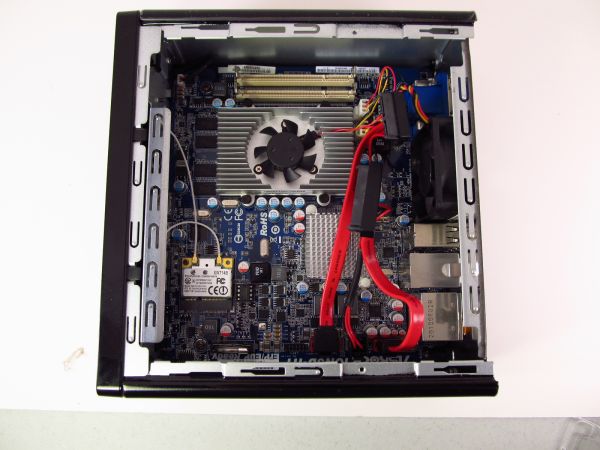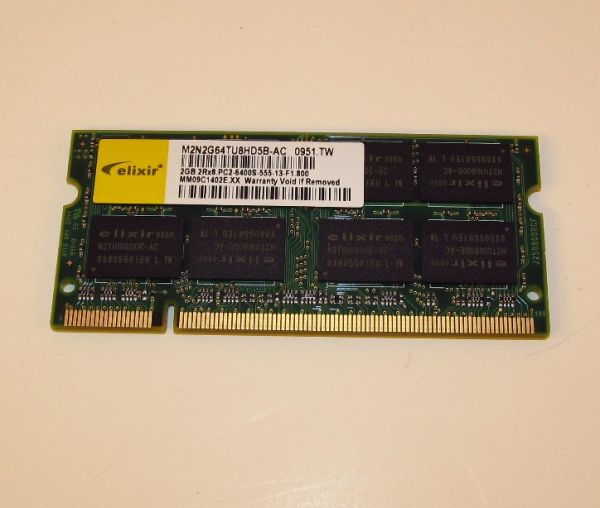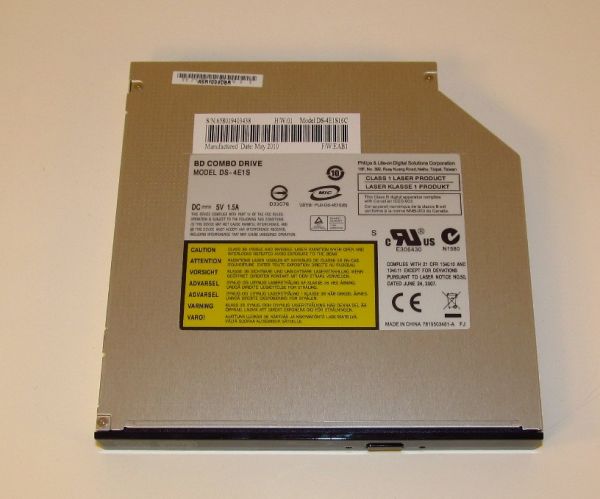ASRock ION 3D - A Next Generation ION HTPC
by Cameron Butterfield on January 14, 2011 3:30 AM EST- Posted in
- Home Theater
- ION
- ASRock
- Media Streamer
- HTPC
System Specifications, Teardown, and Analysis
The ION 3D lists the following as its system specifications:
- Intel Atom D525 dual-core processor
- Microsoft Windows 7 64-Bit
- Mobile Intel ICH8M Chipset
- 1x2GB DDR2 800MHz (expandable to 4GB)
- NVIDIA GT218 NG-ION Graphics
- 320GB 5400RPM HDD (SATA)
- BD-ROM/DVDRW combo drive
With the intent of this machine being a HTPC device, the ION 3D has a lot going for it. We have seen in previous reviews that NG-ION is a valid solution for watching high definition content. The GT218 GPU supports full hardware decode acceleration of all H.264 content; it should be able to play any video content at full 1080P resolution. While the CPU series utilized on this device is the low power Atom, the D525 is the fastest clocked dual-core Pineview iteration that intel has released to date.
The Processor: Intel Atom D525
The Atom D525 used in the ASRock ION 3D runs at a stock clock of 1.8 GHz and has two cores featuring Hyper-Threading, giving the device two physical cores and two logical cores. The CPU has an L2 cache of 512KB per core. ASROCK provides both software utilities and BIOS options that allow you to boost the CPU up to 2.1GHz quite easily. The D525 has a 13W TDP while the form factor of the device is the same as ASRock's models that utilize higher TDP CPUs, which means that ASRock doesn't have to use quite as much cooling on this Atom powered model as their other Mini-PC models
The GPU: NVIDIA NG-ION (GT218)
We've covered the technology used in the NG-ION previously. So far we have seen that the NG-ION is mildly better than the first generation iteration, with a few caveats. There are some limitations due to the PCIe x1 connection to the chipset; however this should not bottleneck HTPC tasks such as H.264 playback and video hardware acceleration, but rather limit the capabilities of gaming and GPGPU functions. The GPU has 512MB of DDR3, and this memory is not shared with the system, unlike integrated graphics solutions. For the intended function of this device the NVIDIA NG-ION will likely prove to be a good choice.
Memory: Elixir DDR2-800 MHz
The D525 processor is one of the models of Atom processor that supports DDR3 RAM, but ASRock choose to use DDR2 on this device. Only one of the slots was occupied in our sample, which means that it is expandable up to 4GB if another stick is added.
Hard Disk: Hitachi Travelstar 5K500.B
The included hard disk is a Hitachi 2.5" drive this time, slightly smaller than the seagate 500GB HDD used in the Core 100HT-BD, but the ION 3D's lower cost comes at the expense of performance and a few different component choices. This particular hitachi model is still a good choice for low power consumption and it's large enough for most users, especially those who will be streaming the majority of their media from a server. This drive can be found for roughly $51 online. It would be nice to see a low cost SSD option (i.e. something like the Intel 40GB drives); that wouldn't add too much of a price premium and would improve boot times and responsiveness compared to a conventional HDD—especially the 5400RPM drive used here.
Optical Disk Drive: Philips / Lite-On Blu-Ray / DVD RW
The ASRock ION 3D ships with the same Lite-On DS-4e1S that was found in the Core 100HT. You get Blu-ray playback functionality and DVD burning capabilities at a reasonable price.
Miscellaneous Components
The ION 3D uses a Realtek RTL8191SU 802.11b/g/n network adapter; this is only capable of connecting to 802.11n 2.4GHz networks and not 5GHz networks. The Vision 3D and Core 100HT seem to use wireless adapters with slightly more features, but this is likely another choice where ASRock has elected to keep costs down.













30 Comments
View All Comments
kpresler - Friday, January 14, 2011 - link
"The included hard disk is a Hitachi 2.5" drive this time, slightly smaller than the seagate 500GB HDD used in the Core 100HT-BD, but the ION 3D's lower cost comes at the expense performance and a few different component choices" should probably be "The included hard disk is a Hitachi 2.5" drive this time, slightly smaller than the seagate 500GB HDD used in the Core 100HT-BD, but the ION 3D's lower cost comes at the expense of performance and a few different component choices"Also, on page 2, "65 AC Adapter" should probably be "65w AC Adapter"
cjs150 - Friday, January 14, 2011 - link
I will be waiting for the AMD version: simple reason the HTPC needs to be connected to high end AV receiver and I would prefer a single HDMI cable to do that.Other key issue for me is noise. I have a high end Sony Blu-ray player and at time I can here it when playing a movie. I am not seeing this issue being address correctly yet by manufacturers. DVD/Blu-ray drives should be soft mounted (or at least better mounted than current). There should be no need for a fan (maybe a very slow running one at worst for whole case) if the case is properly ventilated. One of the problems is that so many case builders persist with mounting HD and optical players above the motherboard. From a heat point of view this is daft, far better would be to mount below the motherboard and then have a sides and top mesh covered to allow better convection (Morena 3500 I think does it this way but is a much less pretty case and still has mounting issues)
tech6 - Friday, January 14, 2011 - link
Agreedhttp://www.tomshardware.com/reviews/asrock-e350m1-...
jabber - Friday, January 14, 2011 - link
I pushed out around 20+ of the previous version for small office upgrades.Nothing but 100% positive feedback. They love them.
vol7ron - Friday, January 14, 2011 - link
I, myself, don't have an HTPC yet. I'm looking to build one with the Ceton InitiTV4, which I've been hounding AT to do a review on (doesn't look like it's going to happen).That being said, if I don't use a tuner card, this looks like something I'd be interested in too - your office must have a nice setup :)
inaphasia - Friday, January 14, 2011 - link
I've got the Asus 1215n netbook (same proc & GPU with the ASRock) but Windows experience is showing 3.2 for Graphics. It's probably just ignoring the ION, question is: should I care? ( I mean I "get" the whole Optimus business of the ION kickin' in when needed...)But more importantly, should I manually update the ION drivers? Keep in mind that Asus don't have newer one's ATM, and nVidia won't recognize the netbook (just keeps scanning).
Thanx!
Calin - Friday, January 14, 2011 - link
Ion is not such a powerful graphic engine, I think Windows Experience is showing correctly a 3.2 (the max I've heard about was something around 6.8).I remember that ION is not using integrated graphics at all, it's not an Optimus platform (but I might be wrong, so take this with a grain of salt)
inaphasia - Friday, January 14, 2011 - link
No and no... sorry:)It IS an Optimus platform and the ASRock's ION Graphics here are showing 5.2!
kilkennycat - Friday, January 14, 2011 - link
I have a 1215N-PU17 and have manually updated the nV driver (from the nV website, ION-Notebook-Win7 32bit) to 260.99, the latest available for ION notebooks. No obvious adverse effects, roughly 2 months since I updated. Like you, the nV scanner did not work and Asus Update remains firmly silent. Iirc, I forced the update because the original Asus shipped driver was unable to play Blurays on the notebook screen; did fine via HDMI. The 260.99 driver has no such problem with notebook screen and Blurays. ( Cyberlink 9 with External usb2.0 portable Bluray reader/DVD-burner).Also the Win7-32 ION laptop driver version of 260.99 comes with an embedded tool that graphically indicates whether Optimus is enabled or not. You can enable it by selecting "Display GPU Activity Icon in the Notification Area" from the "View" drop-down on the nVidia Control Panel screen. This generates an new icon in the Notification Area. If you click on this icon, it will tell you whether ION is running on an app.... The 260.99 View drop-down also has the selection: "Add 'Run with Graphics Processor' to Context Menu". If that is enabled, it adds a new line to the (Right-click)context menu for any of your on-screen icons that says "Run with graphics processor:- " and you can either choose which graphics processor (integrated or ION) to temporarily to run with that app, or permanently set the default graphics processor for that app (brings up the nVidia Control Panel, pointing to that app). fyi: There is a bug here. If the nVidia Control Panel is already open, it may stop working after the Context Menu selection and Win7 complains appropriately. Just close the nV Control Panel app. and repeat the selection from the Context Menu; the nV Control Panel should now open normally.
Disclaimer... "your mileage may vary", update at your own risk!!. As I recall, the Asus version 1217N shipped driver is not listed at all (nether beta nor WHQL) on the nV website. Probably because Asus had to pack something in the machine and their on-disk system backup image as early as possible to comply with manufacturing release. Certainly 260.99 was not available at that time. Very strange that Asus Update still does not offer a 260.99 update. However, if you need to back down for any reason, the shipped driver is in the Asus 1215N downloads on the Asus website. Would recommend a "Create System Restore" before attempting to install the 260.99 driver; With the 260 variety drivers, the nV install mechanism has changed... I suggest selecting ticking the "clean Install" box on the driver Install screen to be sure the old driver is completely purged..
inaphasia - Saturday, January 15, 2011 - link
That's exactly the kind of answer I was hoping for. Can't thank you enough! Deeply appreciated!